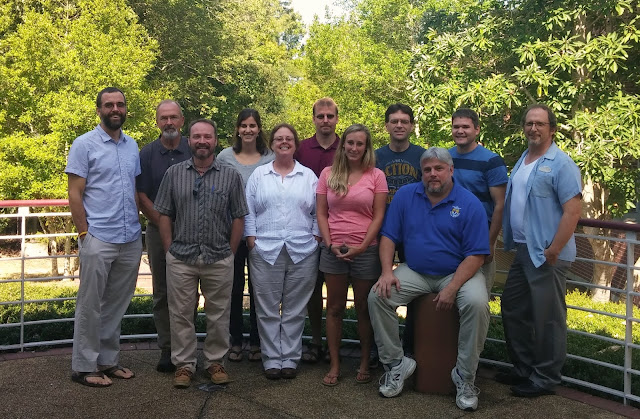In Honor of Ray Semlitsch — friend, colleague and collaborator
This week, the world lost a great man, scientist and amphibian conservationist — Ray Semlitsch. Ray was a prominent amphibian ecologist and advocate for amphibian conservation, particularly with salamanders. I had the honor of working with him at the Flatwoods Salamander Recovery Symposium last summer and his input into the process then, and since then was invaluable. He will be missed. It is our duty to carry the torch for Flatwoods (and other) Salamander Recovery ....
Here is the post from the Missourian, highlighting his life and accomplishments.
-------------------------------------------------------------------------------------------------------------------------
 | ||
| The Flatwoods Salamander Recovery Team at an SDM workshop last summer in Mississippi |
-------------------------------------------------------------------------------------------------------------------------
Ray Semlitsch, an MU Curators' professor of biology and an international leader in amphibian ecology, died Wednesday in Columbia. He was 64.
Dr. Semlitsch's research focused on amphibians in seasonal wetlands and headwater streams. He was particularly interested in how amphibian habitat was affected by a range of disturbance, including land use. His research focused on ways to manage and conserve wetland species.
According to the MU News Bureau, local, state and federal agencies used his work to protect wetlands and terrestrial habitats, as well as to write more effective conservation plans.
Within the past decade, he conducted studies on golf courses in western North Carolina and determined that amphibians could thrive in the streams that crossed fairways. His research demonstrated that negative or positive impacts can result from mankind's interaction and alteration of the environment.
He had a particular interest in salamanders and studied the factors that affected their populations and survival in aquatic environments.
Recently, he and a team of other researchers studied the salamander population in the Mark Twain National Forest and found that these and other amphibians could assist in soil enrichment and insect control. His research provided an example of how all living and non-living aspects of nature are ecologically connected.
Dr. Semlitsch was the recipient of several awards and honors. He was awarded the University of Missouri's 1999 Chancellor's Award for Outstanding Research and Creative Activity, the 2008 National Wetlands Award for Science Research from the U.S. Environmental Protection Agency, and the 2011 Fitch Award for Excellence in Herpetology from the American Society of Ichthyologists and Herpetologists. In 2009, he was elected a Fellow of the American Association for the Advancement of Science.
A colleague of his, Carl Gerhardt, a Curators' professor of biology, said he was impressed by Dr. Semlitsch's passion about his work and his students. Dr. Semlitsch and Gerhardt joint-advised a graduate student who studied sexual selection in common tree frogs.
"He was smart and critical," Gerhardt said. "The project would not have been able to get off the ground without his expertise."
Tom Anderson, a graduate student who worked in the Semlitsch lab, said that Dr. Semlitsch was a great mentor.
"He was very good at motivating and encouraging us," Anderson said. "His own work ethic and experience was an example of how to be successful. He was a great person to be around."
Dr. Semlitsch served in the U.S. Marine Corps from 1968 to 1972.
He graduated with a bachelor's degree in biology from SUNY College at Buffalo in 1975, a master's degree in zoology from the University of Maryland in 1979, and a doctorate in zoology from the University of Georgia in 1984.
Before joining the faculty at the University of Missouri in the Division of Biological Sciences, he held positions at Memphis State University and the University of Zurich, Switzerland.
Services will be announced at a later date.
Supervising editor is Allison Wrabel.




Comments
Post a Comment